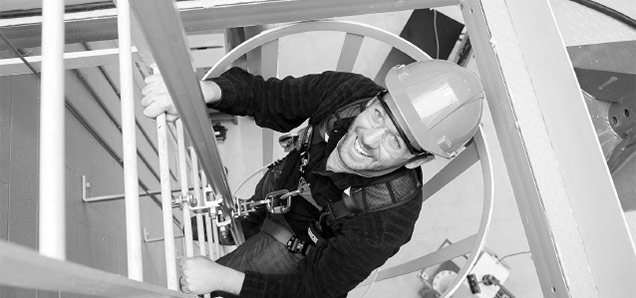Renewable Energy program catching wind in the industry
 CREDIT: JOHN SING
CREDIT: JOHN SINGGraduate Jonathan Irwin climbs a structure as part of the Renewable Energy Technician program.
About 50 per cent of graduates from the Renewable Energy Technician program already have jobs, and the other half are being courted by people from Borea Construction, who stopped by the Fanshawe St. Thomas campus on October 16 for interviews.
The need in the industry was what urged program co-ordinator Bruno Castellani to form the program in the first place.
Castellani is co-ordinator of four programs (including Renewable Energy) at the St. Thomas campus, and said he'd noticed a trend with graduates of his Electronic Engineering Technician — Industrial Controls and Mechanical Engineering Technician — Industrial Maintenance programs.
“Some of those students were getting involved in renewable energy, and specifically they were getting jobs as wind turbine maintenance technicians or wind turbine tower erection,” he said. “We probably had 15 to 20 students working in renewable energy from those two programs.”
Students were hired for their skills, but they didn't have everything employers needed, and that's when an advisory committee with industry experts was formed.
“The answer was pretty clear,” said Castellani. “Employers were contacting me and it was such a new industry that they didn't really have anywhere to draw from, in terms of new talent to hire into the industry.”
It was evolved over a two- to three-year period, and in September 2012, the Renewable Energy Technician program had 31 students. On October 11, 24 students graduated.
Wind Magazine, a part of Canadian Wind Energy Association, caught wind of the program and featured it in the summer issue this year.
“I think they were pretty impressed with how we have made wind such a large part of our program,” he said. “We're very focused on wind and photovoltaics [and] they saw that was something worth investigating.”
The program is still relatively new, but Castellani is already thinking ahead, armed with shortand long-term goals.
“Our short-term goals are to continue to fulfill the needs of the photovoltaic and the wind turbine industry,” he said, as this is something he thinks the program is doing well already.
And in the long-run, “Incorporating into the program important, new renewable energies such as biomass/biogas, [and] perhaps geothermal.”
“We would like to make this program a flagship renewable energy program for the college.”
Castellani said there is room to grow in the industry and demand for his students will only increase.
“We think that the province is poised for a tremendous amount of growth,” he said. “We are only at about the three per cent level. We've got growth potential that will increase that from three per cent to a much higher point of return on renewables.”
Because of that, Castellani doesn't worry about graduates finding jobs. “If we had more students, we know that they would be placed.”
“I'm very pleased with the calibre of students this program has attracted. We got such enthusiastic, hardworking students, and they were all here for the right reasons ... That's pretty gratifying to hear as a student, that the students weren't saying they were here for money or glory, they were here for good reasons. And they showed that.”
Fanshawe's Renewable Energy Technician program is only one of a handful of programs in Ontario.













